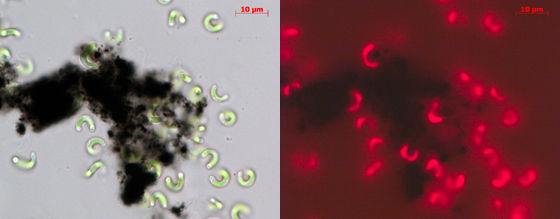Nanotubes «rob» green algae of space and light
Advertisement
nanoparticles such as carbon nanotubes (CNT), which are found in an ever-increasing number of products, are ending up more and more frequently in our surroundings. If and how they affect aquatic ecosystems are questions which are still unanswered. An Empa study shows that while CNTs do not have toxic effects on green algae they do inhibit its growth by depriving the plant of light and space.

Carbon nanotubes are not poisonous to green algae, but they do slow the growth of these organisms at high concentrations because they cause clumping which leads to the algae receiving less light. Left: intact algae (green) in a clump of carbon nanotubes (black). Right: "normal" photosynthetic activity of the algae (red) made visible by fluorescence.
Empa
Carbon nanotubes (CNTs) are up to 100,000 times thinner than a human hair and as light as plastic. Despite this they have a higher tensile strength than steel, are harder than diamond and conduct electricity better than copper. These properties make CNTs a raw material with a very promising future. All over the world possible applications are being investigated, including use in solar cells, plastics, batteries, medical technology and the purification of drinking water.
With the increasing industrial production of CNTs now reaching the level of hundreds of tons per year, the quantity of these particles which could be released into the environment has also risen. Certain studies have raised the possibility that CNTs lodged in the lungs might cause similar health effects as do asbestos fibers. An interdisciplinary team of scientists from Empa and the Agroscope Reckenholz-Taenikon (ART) Research Station have now begun investigating the fundamentals of how CNTs behave when they are deposited in waterways and lakes.
Algae remain healthy but grow slower
In the course of the project, which is financed by the Swiss National Funds, researchers further developed a standard chemical method in order to measure the growth and photosynthetic activity of green algae exposed to CNTs. They discovered that even in the presence of high concentrations of CNTs the algae retain normal levels of photosynthesis, although growth rates are reduced. Also noticeable was that when CNTs are added to the algae suspension, its color darkens and the algae forms clumps with the nanotubes. Despite this there is no evidence that the nanotubes are absorbed by the plants.
The investigators came to the conclusion, therefore, that the algae grow more slowly because they stick together as a result of the presence of CNTs and therefore receive less light. To prove this, they developed two further tests which allowed them to measure quantitatively the shadowing and agglomeration effects the nanotubes had on the algae. The results show that the slower growth of the organisms is in actual fact primarily due to these two factors. The conclusion is therefore that CNTs are not directly toxic to green algae, as earlier studies indicated. In the presence of CNTs, algae simply do not enjoy ideal growth conditions because, like land plants, they need sufficient room and light to do so.The clumping and shadowing effects which were observed only manifest themselves at elevated CNT concentrations of more than one milligram per liter, however. These levels of carbon nanotubes concentrations are currently unlikely to be met in the environment.
«Our study shows how difficult is to understand in detail the effect of nanomaterials on organisms», says Empa and ART researcher Fabienne Schwab. The results will help to test other nanoparticles to ensure that the safety of humans and their environment is guaranteed. Empa researcher Bernd Nowack advises that until comprehensive, long term results are available for complex organisms such as green algae, nanoparticles (particularly unbound nanoparticles) should not be released into our environment.




























































